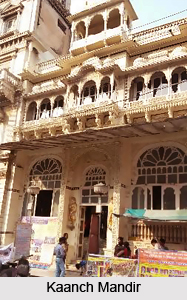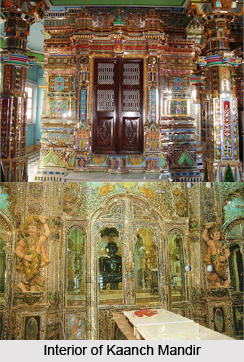 Kaanch Mandir is a famous temple situated in Indore, the largest city of the Madhya Pradesh state of India. Kaanch Mandir or "Glass Temple" is entirely made up of glass and mirrors. It is primarily a Jain temple but it can be visited by devotees from all religions. The Jains are followers of Mahavira, which is a much stern religion compared to Buddhism. Mahavira was the last Ttirthankara, who is a man behind creating the four-fold order namely Monk, Nun, Layman and the Laywoman. There are two different sects of Jains- Digamvaras and the Swetamvaras. These aspects of Jainism have been elaborately carved on the walls of the Kaanch Mandir.
Kaanch Mandir is a famous temple situated in Indore, the largest city of the Madhya Pradesh state of India. Kaanch Mandir or "Glass Temple" is entirely made up of glass and mirrors. It is primarily a Jain temple but it can be visited by devotees from all religions. The Jains are followers of Mahavira, which is a much stern religion compared to Buddhism. Mahavira was the last Ttirthankara, who is a man behind creating the four-fold order namely Monk, Nun, Layman and the Laywoman. There are two different sects of Jains- Digamvaras and the Swetamvaras. These aspects of Jainism have been elaborately carved on the walls of the Kaanch Mandir.
History of Kaanch Mandir
The Jain king known as Cotton King, Sir Hukumchand Seth erected the temple. Hukumchand was a successful trader in his time. He built his mansion just adjacent to temple. He named the mansion as "Sheesh Mahal" which means "Glass Palace".
 Architecture of Kaanch Mandir
Architecture of Kaanch Mandir
The Kaanch Mandir of Indore is primarily a temple built exclusively with glass shreds and cuttings. The exteriors are built plainly, while the entire interior-walls, ceilings, floor, pillars and doors are all embellished with glass. The glasses are coloured, displaying a rare innovation and brilliance. The materials for the temples have been collected from various places like Italy and Europe. They include the Chinese Lantern Type coloured glass and Cut Glass Chandeliers. Intricately painted numerous glass paintings can be reviewed, which prove that they have been handled with care and meticulousness. The glass beads and the raised figure have a misleading impact on the eye, creating a three-dimensional effect and the effect of expansiveness. Elaborate inscriptions can also be seen decorated on the glass walls Kaanch Mandir of Indore.
The temple is also adorned with more than 50 murals depicting Jain stories. They also portray scenes of conversion to Jainism and torture of sinners in the afterlife. The temple houses the idol of Lord Mahavira, the founder of Jainism. The idol is made from shimmering black onyx.
Connectivity of Kaanch Mandir
Kanch Mandir is situated in such a location that it can be easily accessed by air, rail and road ways. It is close to Maharaja Tukoji Holkar Cloth Market on Hukumchand Marg and North of Lalbagh palace. The nearest railway station is Indore railway station. In terms of accommodation, devotees and tourists can stay at hotels like Lemon Tree, Gold Leaf, Nahargarh Haveli, Hotel Natraj, Paradise, and Roma Palace to name a few.





















